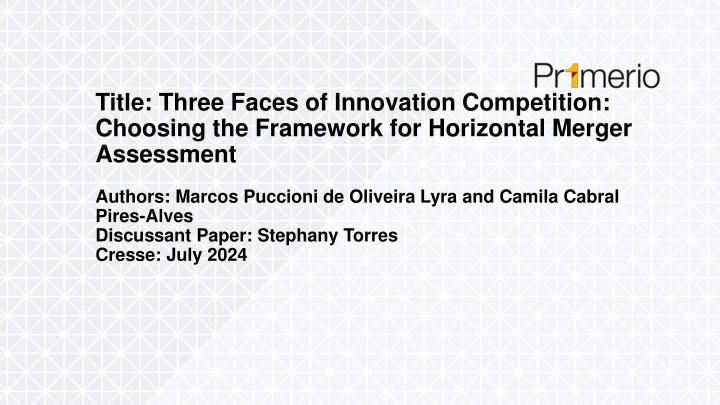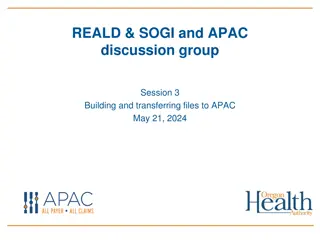
Innovation Competition in Horizontal Mergers: A New Framework
Explore the impact of horizontal mergers on innovation competition through a capabilities-based approach, addressing traditional assessment challenges and proposing tailored evaluations for different innovation scenarios. This framework enhances merger assessments, protects innovation incentives, and promotes dynamic competition in the market.
Download Presentation

Please find below an Image/Link to download the presentation.
The content on the website is provided AS IS for your information and personal use only. It may not be sold, licensed, or shared on other websites without obtaining consent from the author. If you encounter any issues during the download, it is possible that the publisher has removed the file from their server.
You are allowed to download the files provided on this website for personal or commercial use, subject to the condition that they are used lawfully. All files are the property of their respective owners.
The content on the website is provided AS IS for your information and personal use only. It may not be sold, licensed, or shared on other websites without obtaining consent from the author.
E N D
Presentation Transcript
Title: Three Faces of Innovation Competition: Choosing the Framework for Horizontal Merger Assessment Authors: Marcos Puccioni de Oliveira Lyra and Camila Cabral Pires-Alves Discussant Paper: Stephany Torres Cresse: July 2024 1
Introduction Overview: Comprehensive analysis of horizontal mergers' impact on innovation competition. Proposes a capabilities-based approach for merger assessment. Key Points: Challenges with traditional merger assessments. Importance of innovation competition. Capabilities-based assessment. 2
Assessment Challenges and Innovation Competition Challenges: Traditional assessments focus on price effects. Inadequacy in addressing innovation competition. Innovation-Driven Industries: Continuous improvements. Development of new products. Need for Nuanced Approach: Impact on firms' incentives to innovate 3
Capabilities-Based Assessment Central Argument: Shift from traditional market structure variables. Focus on firms' innovation capabilities. Benefits: Accurate evaluation of merger impact on innovation. Recognition of dynamic innovation processes. 4
Literature Review and Practical Application Existing Literature: Gaps in current competition policy practices. Proposed Framework: Capabilities-based assessment. Examples from US and European case law. Challenges Addressed: Consistent assessment of mergers' impact on innovation. 5
The Three Faces of Innovation Competition Framework Framework Overview: Categorizes innovation competition into three scenarios: Continuous innovation in the product market. Ongoing innovation for new products. Future innovation efforts. Framework Application: Theories of harm. Evidence and practical challenges. Structured Approach: Tailored assessments for different innovation competition types 6
Implications for Competition Policy Insights: Complex relationship between mergers, innovation, and policy. Capabilities-Based Approach: Enhances merger assessments. Protects innovation incentives. Policy and Practitioner Incorporation: Effective decision-making. Promotion of dynamic competition. 7
Additional Points on Assessing Innovation Competition Detailed Discussion: Factors like firms' history, rivalry, and market proximity. Innovation Capabilities Evaluation: Innovation potential and barriers to entry. Comprehensive Understanding: Impact of mergers on innovation competition. 8
Differentiating Cases with Existing and Non-Existing Product Markets Categories: Existing product market cases. New product market cases. Concerns: Potential innovation slowdowns. Protection of existing sales. Tailored Assessments: Address product and innovation competition effectively. 9
Importance of Evaluating Future Innovation Efforts Significance: Long-term implications on innovation incentives. Dynamic Inefficiencies and Selective Efficiency: Assessing long-term effects on innovation. Preserving Innovation Incentives: Ensuring dynamic competition. 10
Applying a Capabilities-Based Approach Comprehensive Assessment: Firms' abilities to innovate beyond traditional R&D. Core Capabilities and Competences: Cumulative technology cases. Entry conditions into the innovation market. Accurate Competitive Landscape: Identifying sources of competitive pressure. 11
Case Studies: Dow/Dupont and Visa/Plaid Dow/Dupont Case: European Commission assessment. Visa/Plaid Case: Department of Justice investigation. Insights: Importance of evaluating capabilities. Impact on future innovation efforts. 12
Critique Overemphasis on Capabilities-Based Approach While the capabilities-based approach offers a comprehensive framework, one critique is its potential overemphasis on firms' capabilities. This focus might overlook other crucial aspects of competition, such as market dynamics and consumer behaviour, which are also vital for a holistic assessment. Practical Implementation Challenges Another point of criticism is the practical implementation of the capabilities-based approach. Assessing firms' capabilities in detail requires extensive data and resources, which may not always be available to competition authorities. This could pose significant challenges in applying the framework consistently. Potential Bias in Assessment The capabilities-based approach could also introduce potential bias in assessment. Firms with well-documented capabilities might be favoured over those with emerging but less recognized innovation potential. This could inadvertently stifle competition from smaller or newer firms that are still developing their innovation capabilities. 13
Conclusion Framework Summary: Horizontal merger assessment with innovation competition. Capabilities-based approach. Enhancing Understanding: Impact on innovation incentives. Promoting Dynamic Competition: Innovation-driven industries. 14
Q&A Questions and Discussion: Open floor for audience questions. Further exploration of discussed concepts 15













